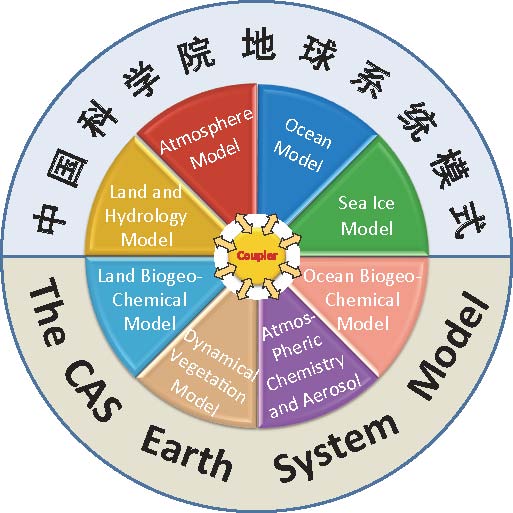Numerical modeling is an important way to study evolution mechanism of whole earth spheres and its prediction of future climate status provides science advice to policy makers. Along with improved understanding of the earth, the physical and chemical processes in the model are well represented. Still, the traditional climate system model has been unable to meet societal needs. In particular, Chinese President XI Jinping proposed that China's carbon dioxide emissions should reach its peak by 2030 during the seventy-fifth UN General Assembly held in September 2020, and strive to achieve carbon neutrality by 2060.While the processes closely related to carbon cycle, such as ecology and terrestrial marine biogeochemistry, are not taken into consideration in the traditional climate system model, it is therefore urgent to develop an earth system model (ESM), which includes processes such as aerosols, atmospheric chemistry, dynamic vegetation, biogeochemistry and carbon/nitrogen cycle.
Recently, Journal of Advances in Modeling Earth Systems (JAMES) published an article entitled "Description and Climate Simulation Performance of CAS-ESM Version 2", which introduced the second version of CAS-ESM. The first author of the paper, Dr. ZHANG He, associate scientist of the Institute of Atmospheric Physics (IAP), CAS, said "CAS-ESM2.0 is the first ESM developed independently by Chinese scientists. There are now 8 component models in the CAS-ESM2.0, including atmospheric model IAP AGCM5.0, ocean model LICOM2, land model CoLM, ice model CICE4, aerosols and atmospheric chemistry model IAP AACM, dynamic vegetation model IAP DGVM, land biogeochemistry model embedded within the CoLM land model, and ocean biogeochemistry model IAP OBGCM."
The processes of marine and land biogeochemical, dynamic vegetation, fire, and atmospheric chemistry, that are closely related to carbon cycle and ecological process, are considered in the CAS-ESM2.0. Therefore, instead of being prescribed in traditional climate system model, the future carbon dioxide concentration can be predicted in CAS-ESM2.0. In addition to global simulation, CAS-ESM2.0 also includes a regional component model (WRF), which can couple with the global model and provide the refined simulation of regional climate.

CAS-ESM (Image by IAP)
“CAS-ESM2.0 can reasonably simulate the meridional heat transport of the atmosphere and ocean, along with the vertical distribution of the Atlantic Meridional Overturning Circulation (AMOC). The climatological features of ocean temperature, salinity and sea ice density are well captured by CAS-ESM2.0.” said ZHANG. In addition to the JAMES paper, the data description articles of CAS-ESM2.0 have also been published in the CMIP6 special issue in Advances in Atmospheric Sciences.
"This is just a good start and we still have a long way to go. There are 23 MIPs in CMIP6, and we will continue to complete other experiments and share the simulation results with scientists around the world. In addition, we need to further improve the performance of the model, so that CAS-ESM2.0 can provide better evidence and support for national strategies, such as ‘Beautiful China’, ‘the Belt and Road Initiatives’, and ‘Carbon Neutrality’.” Said ZHANG.
References:
Zhang, H., Zhang, M., Jin, J., Fei, K., Ji, D., Wu, C., et al., 2020: Description and climate simulation performance of CAS-ESM version 2. Journal of Advances in Modeling Earth Systems, 12, e2020MS002210. https://doi.org/10.1029/2020MS002210 .
Dong, X., Jin, J., Liu, H., Zhang, H., Zhang, M., Lin, P., et al., 2020: CAS-ESM2.0 model datasets for the CMIP6 Ocean Model Intercomparison Project Phase 1 (OMIP1). Adv. Atmos. Sci., https://doi.org/10.1007/s00376-020-0150-3 .
Jin, J., Zhang, H., Dong, X., Liu H., Zhang M., Gao, X., et al., 2020: CAS-ESM2.0 Model Datasets for CMIP6 Flux-Anomaly-Forced Model Intercomparison Project (FAFMIP). Adv. Atmos. Sci., doi: 10.1007/s00376-020-0188-2 . http://www.iapjournals.ac.cn/aas/en/article/doi/10.1007/s00376-020-0188-2
Media contact: Ms. LIN Zheng, jennylin@mail.iap.ac.cn
